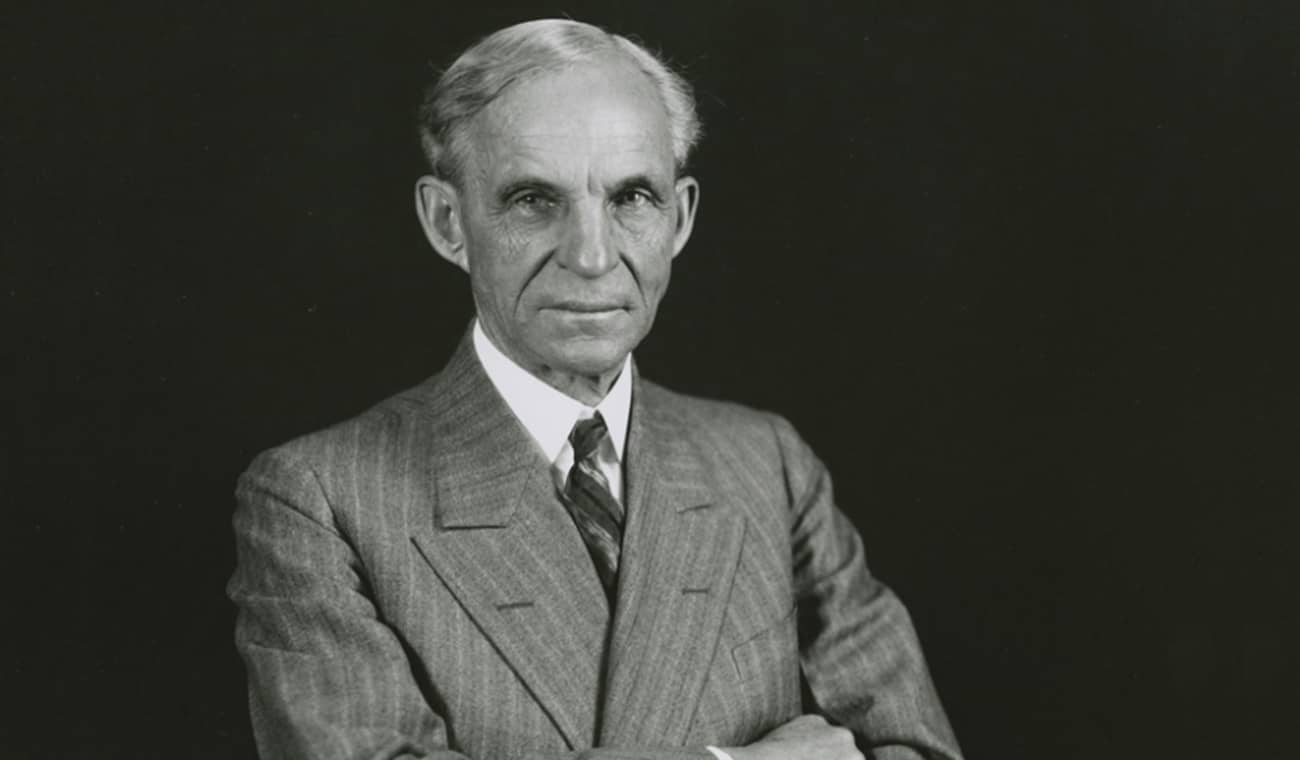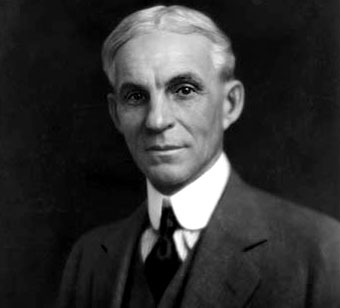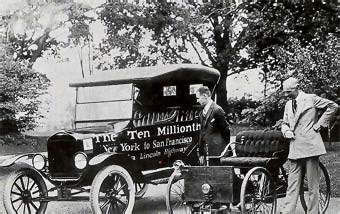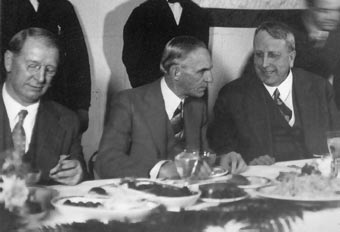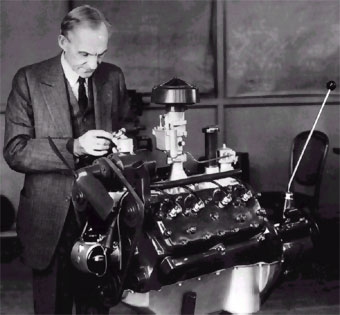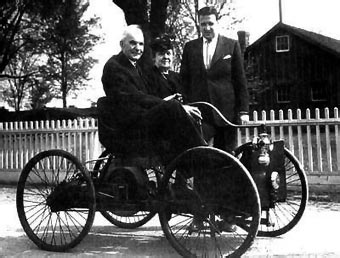The American engineer and businessman Henry Ford radically modified the customs and consumption habits of society, thanks to his innovative way of understanding industrial production. On the one hand, it was able to produce inexpensive and reliable automobiles, available to a large number of consumers; on the other, it transformed the working methods of the industry, to make it more productive. At the time of his death in 1947, this son of poor Irish farmers had not only amassed a fabulous personal fortune and spawned a family of entrepreneurs who expanded his industrial empire, but he was proud to be one of the men who more have influenced the so-called American way of life. Your Ford T is featured in many museums today as a work of art comparable to great human creations.
Henry ford
Born on June 30, 1863, in Dearborn, Michigan, Henry Ford demonstrated from a very young age some unusual conditions for mechanics. As soon as he finished his high school studies in Dearborn, he moved to Detroit to work as a mechanic’s apprentice, although not long after he would return to his hometown, making a living as a steam engine mechanic. In 1888 he married Clara Jane Bryant, his lifelong companion, who would give him an only son, Edsel (born in Detroit in 1893), a brilliant and imaginative man who could have been a great company director had he not lived overshadowed by the gigantic figure of his father. Ford returned to Detroit in 1891 and went to work as a mechanic at the Edison Illuminating Company, of which he would become chief engineer.
In those years he began the construction, in his spare time, of what would be his first «horseless carriage», which culminated in 1896. It was a four-wheeled vehicle powered by a two-cylinder, four-stroke engine, cooled with water. and no reverse gear. This model did not provide any mechanical novelty compared to those made in Europe by Daimler or Benz. Its importance would come later, with serial construction, and thanks to its benefits, economy and robustness, virtues destined to satisfy the needs of the middle class.
During the early years of the century, Henry Ford built his reputation as a mechanic by successfully driving his own racing cars. He associated with other automobile companies, but his strong character and unconventional ideas led him to found the Ford Motor Company in 1903, of which he owned 25.5% of the shares. At the time of its founding, the company had only a few patents and a prototype built with the help of C. Harold Willis that was not even finished.
The overwhelming triumph of the Ford T
He and his partners, mainly the brother’s John and Horace Dodge, manufacturers of the engines, began to reap the first successes, and with them came the differences of opinion. Dodges favored a high-priced, luxury model, while Ford advocated the exact opposite, that is, a very simple and popular car, and above all cheap. The differences end up being so serious that Ford chooses to buy half of the shares, leaving Dodge in the minority. Now he not only knows what he wants but, from different attempts, he even knows how it should be done, and as a result of all this the Ford T was born, which went on sale in 1908. Only five years later, Henry Ford already It is capable of putting 25,000 units on the street annually at a price of $500, with profits of more than $11 million.
The ten millionth car, along with
the first one that left the Ford factory
From here on, analysts of the Ford phenomenon disagree. For some, the secret of his success was that he understood that the desire of every American was to have a self-propelled vehicle capable of giving him the freedom of action that characterizes the American dream. For others, on the other hand, the process was exactly the opposite: what Henry Ford did, thanks to his ingenuity and industry, was to make available to anyone the possibility of buying a car, with which he would have built the mythical model at the same time T and the American dream.
In one case or another, and from a strictly business point of view, Henry Ford’s true secret was that he was able to combine three factors that not only revolutionized the automobile industry but American society as a whole. The first of these factors was the standardization and mass manufacturing of each and every one of the parts that make up the car so that by converging orderly on the assembly line, a hundred long units could be assembled per day; Without being its inventor, its automobile factories thus became the benchmark for large-scale mass production, a production method that continues to this day and was one of the great innovations of the second stage of the Industrial Revolution.
The second factor was the granting of high salaries (“exorbitant”, in the opinion of their rivals) to the workers of their factories, who, finding themselves with sufficient financial resources, immediately became the main consumers of Ford T. Finally, Ford established on a national scale a dense network of dealers who maintained a close relationship with the headquarters since in many cases the rudimentary foundations of what today are the parallel financial companies that promote installment sales were founded. At forty, Henry Ford was not only the world’s leading carmaker but one of the richest men in the country.
Pacifist in war
But he still had many tough tests left to temper his indomitable Irish spirit. On the eve of the American entry into World War I, and when the conflict had already become widespread in Europe, Ford personally launched a campaign for peace as passionate as it was ridiculed by his opponents. He even chartered the so-called Peace Boat while financing pacifist organizations in their futile effort to stop the war. However, being a pragmatic man, he did not hesitate for a moment to put all his factories at the service of the government when he understood that war was inevitable, obtaining multimillion-dollar contracts for the manufacture of war vehicles and weapons.
Henry Ford with Knox and William Hearst
Parallel to his efforts in favor of peace, Henry Ford had to fight a tough legal battle against the Dodge brothers, who at the head of a large sector of minority shareholders opposed the tycoon reinvesting the profits of his company in expanding and consolidate it. This was against the interests of John and Horace Dodge, who were more interested in collecting the dividends to invest in their own car factory. Forced in 1919 by a judge to distribute almost twenty million dollars among his shareholders, Ford reacted with a brutal counteroffensive and in a matter of weeks, and through interposed agents, invested more than one hundred million dollars in seizing almost all of shares of the Ford Motor Company.
The times, however, were no longer so good. In 1920-1921 there was a severe recession that was like the prelude to the crisis of 29. Ford saved the pothole at the cost of further reducing the price of the Model T ($360), launching the famous Fordson tractor and forcing his dealers to finance in part not only the purchase of his own company but the large investments he was carrying out. In 1922 he bought the Lincoln Motor Company and put his son Edsel in charge of it with the aim of manufacturing a luxury model.
Simultaneously, and in order to be able to control all stages of the manufacture and sale of its automobiles, it began the systematic purchase of forests, coal and iron mines, glass factories, blast furnaces, a railway, a merchant fleet and an immense plantation of rubber in Brazil, while, to further diversify the offer, it started the manufacture of tri-engine aircraft, making passenger and mail air transport experience a gigantic advance in North America. Henry Ford was also the first to see the advantages of the foreign market and established a complete sales network in Europe. By the mid-1920s, the Ford T accounted for 40-57% of the car market. However, just on the eve of the great depression of 29, Ford did not know (and in part did not want,
The crisis of 29
The noticeable increase in the road network, together with the general rise in living standards, as well as direct competition from rivals such as General Motors, made the Ford T an obsolete model. But Ford, seeing the misleading sales figures of its standard-bearer, was reluctant to change it and opted for the old resource of reducing costs, only this time it only remained to increase productivity and freeze wages, which significantly decreased popularity. Ford among the once highest-paid blue-collar workers in America.
The dramatic decline in sales during 1927 forced Ford to discontinue production of the Model T. At the end of that year the Ford A went on sale and shortly thereafter, in 1929, the astonishing V-8, which allowed it to recover something of the lost ground. But the Ford Motor Company is no longer number one because both General Motors (with the famous Chevvy) and Chrysler are ahead. With the aggravating circumstance that the boss seems to have lost his way: his weekly, the Dearborn Independent, is launching a furious anti-Semitic campaign; neither the subsequent disavowal of Henry Ford himself nor his public apology will prevent his reputation from plummeting.
Henry Ford in front of a V8 engine
The immense power he enjoyed within his conglomerate of companies, the impossibility of exercising direct control of all of them, and the fact that Ford was better in mechanical matters than in human relations resulted in his many times delegating his power to people who are more notable for their helpful attitude than for their entrepreneurial skills. Thus, the beneficial influence that a thoughtful and thoughtful man like his son Edsel had had over the company since 1925 was largely offset by the broad powers vested in Harry Bennet, Ford’s chief of security services.
Bennet was largely responsible for Ford’s repeated and stubborn refusal to sign the National Industry Recovery Act, a government formula put into practice during the 1930s to help overcome the crash of 29 and that involved substantial state contracts but that forced the employers to agree with the unions. At the end of that decade, and when it became clear that Hitler would end up dragging the United States into World War II, Henry Ford again publicly opposed the war. But nothing else was known about the Japanese attack on Pearl Harbor and the withering declaration of war decreed by President Woodrow Wilson, it put its gigantic potential at the service of the State and from its factories, the first superbombers destined to restore US war supremacy would soon emerge.
The legacy of the great industrialist
The false prosperity provided by the state contracts did not manage to hide the serious deficiencies that afflicted the Ford Motor Company, mainly due to the notorious technological delay experienced by its founder’s efforts to continue producing cheap and therefore technically mediocre vehicles. In this sense, it is worth noting the positive influence exerted by Edsel Ford, which could have been further increased due to the repeated heart problems suffered by Henry Ford in the early 1940s. Unfortunately, Edsel died in 1943, and Henry Ford, then an old man in his eighties and in bad health, no longer had the strength to regain command of that drifting ship.
With his wife and grandson Henry Ford II on
the quad that he had built in 1896
Until in 1945, and after a kind of family coup in which the founder’s wife, Clara Jane Bryant, had an outstanding performance, Edsel’s son, Henry Ford II, was raised to the presidency with the mission of restructuring, clean up and update the fabulous conglomerate of companies built by Henry Ford. At the time of his death, which occurred in April 1947, Henry Ford had the satisfaction of knowing that his empire was once again a machine that worked at full pressure and that it fought advantageously on all fronts opened by him.
However, times had changed and it was no longer possible to continue to run that empire on a family basis. In 1956, seven million shares of the Ford Motor Company went up for sale, ending the absolute control exercised by the Fords. Much of the profits currently generated by the company go to the Ford Foundation, created in 1936 and subsequently strengthened by the legacies left by Henry Ford himself, his wife Clara and their son Edsel, currently totaling more than half a billion of dollars devoted entirely to the advancement of research and the arts.




